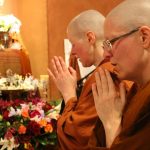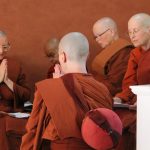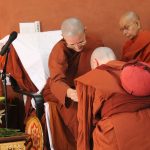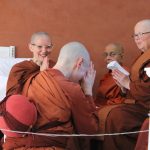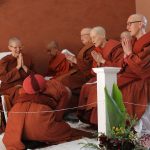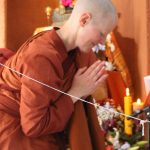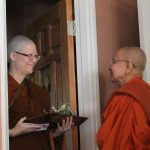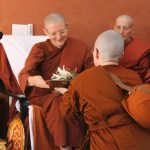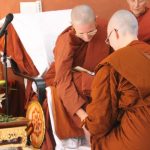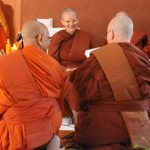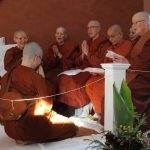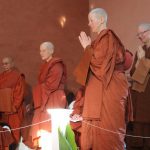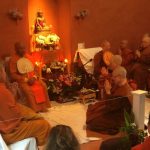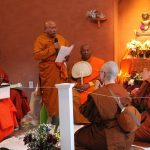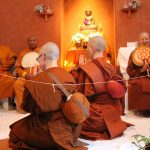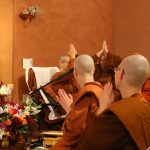Buddhist Women on a Path of Spiritual Awakening
Mothering: A Quintessential Quality of Practice
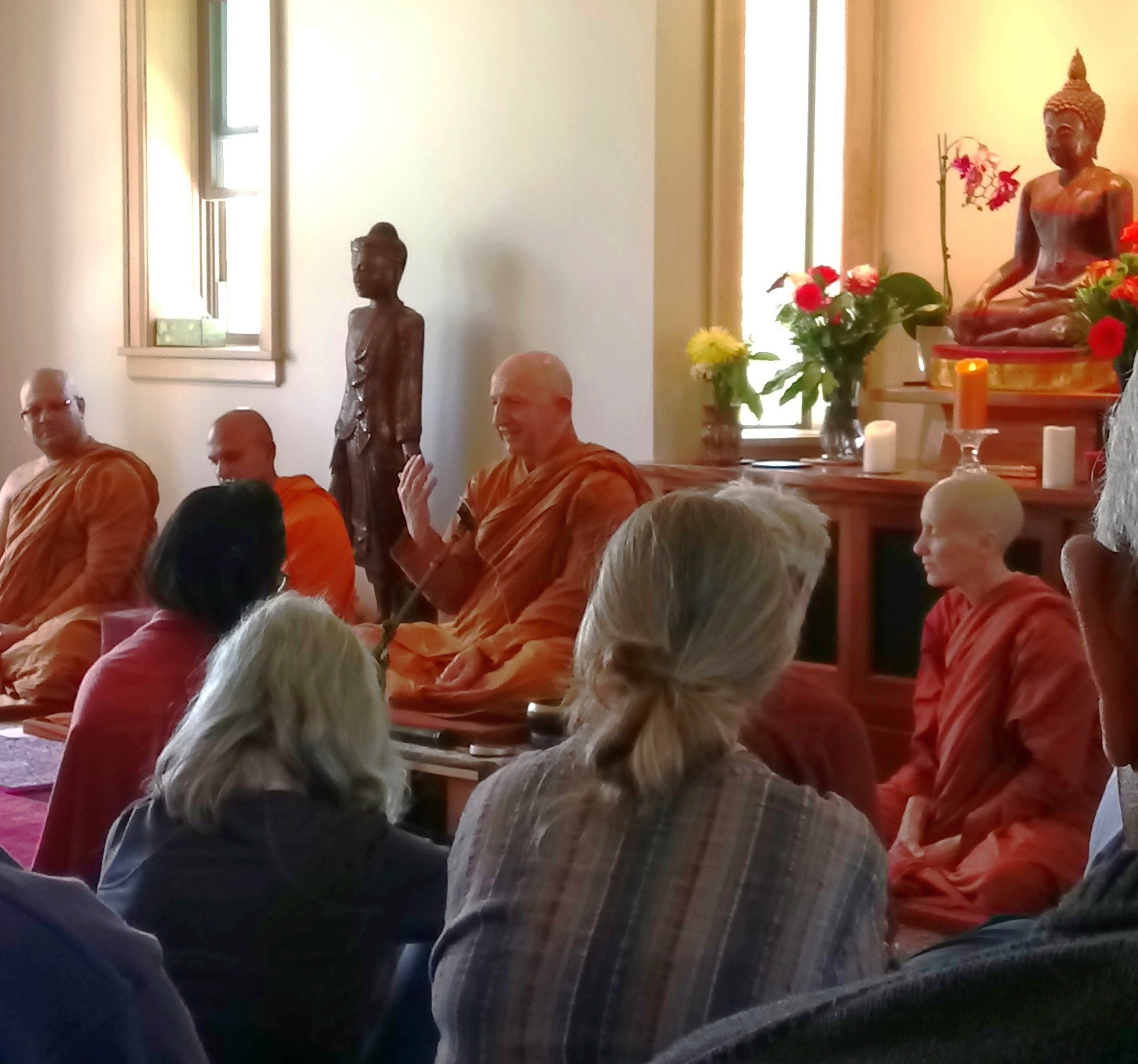
On May 13, 2018, we were blessed with a visit by Ajahn Amaro, abbot of Amaravati Buddhist Monastery, members of the Tisarana monastic community, and many devotees from near and far who were also present to listen to his Dhamma talk on Mothering: A Quintessential Quality of Practice. He spoke about the extraordinary qualities of ‘Mother’ that are manifest in the Buddha’s teachings and within each of us through our Dhamma practice. May his words continue to enrich and uplift us.
Gratitude to Parents Day
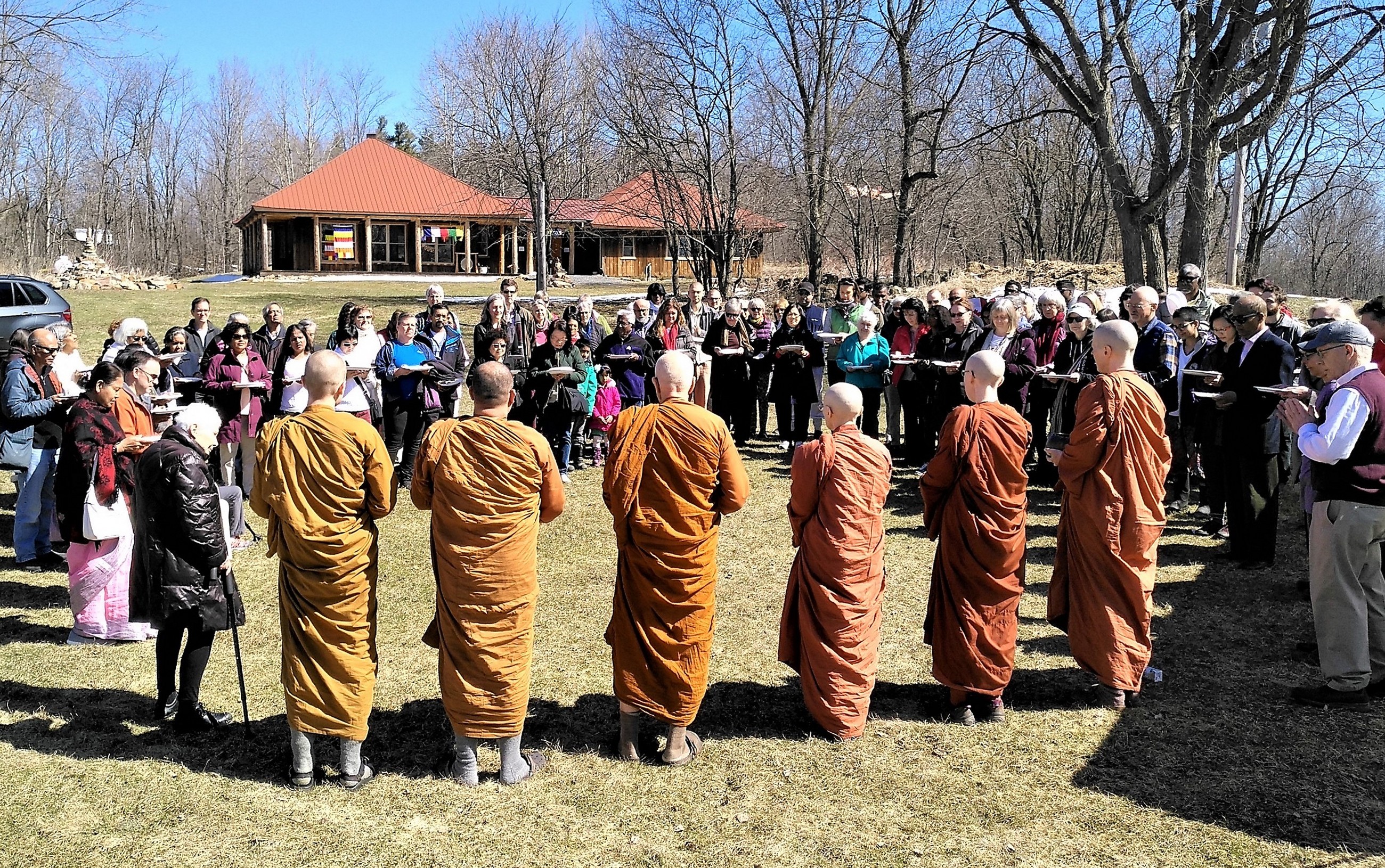
On Sunday, April 22, 2017, with hardly a trace of the snow storms that had blanketed the area just 24 hours before we began, we held a special day of remembrance attended by nearly 120 members of the Tisarana Monastery and Sati Saraniya Hermitage communities to honour our parents.
We quickly felt united in the joy of bringing together our good intentions and gratitude for mothers, fathers, teachers, family members, friends, and loved ones. We decorated a memorial shrine to our parents with precious photos and colourful Spring tulips; we shared nutritious foods and joined our voices in a chorus of chants of peace, homage and thanksgiving; and we listened with rapt attention to the heart-warming Dhamma talk by Ajahn Viradhammo about the meaning of gratitude to our parents and the journey they set us on through this life.
May we always remember the gratitude we have to our parents and teachers by supporting and nurturing them both physically and spiritually – while we still can. In this spirit, may we learn to parent ourselves in the ways of wisdom, compassion and true happiness. And may these blessings, in turn, be shared with all beings in the ten directions.
“These three manifestations are rare in the world:
A Buddha is rare in the world.
A person who teaches the Dhamma and Vinaya is rare in the world.
A grateful and appreciative person is rare in the world.”
(adapted) Anguttara 3:114, ‘Rare’
Fulfilling the Buddha’s Legacy for Women
After a hiatus of a thousand years, Theravada Buddhism has been experiencing a true renaissance of the Bhikkhuni Sangha in North America. On Dec. 3, 2017, Ayya Anuruddha together with Ayya Niyyanika received their full ordination as bhikkhunis in a beautiful ceremony at Dhammadharini Monastery in Penngrove, California. These joyful ordinations by an act of the dual Theravada Sangha were led by Ven. Pallawela Rahula Mahathero for the bhikkhus and Ven. Tathaaloka Mahatheri for the bhikkhunis.
Ayya Anuruddha will remain at Sati Saraniya Hermitage to continue serving the community in Canada. In fulfilling the Buddha’s legacy, these rites of passage revive an ancient spiritual pathway for women to awaken and serve as protectors of peace, compassion, and wisdom in our troubled world.
Meditation Practice in Toronto

Late November meditation practice opportunities:
Ayyā Medhānandī will be leading three meditation events in Toronto: November 24-26, 2017, co-sponsored by Satipaññā Insight Meditation Toronto (SIMT) and the Therāvada Buddhist Community of Toronto (TBC). All 3 sessions will be held at The Centre, 316 Dupont St., Toronto.
Nov. 24 – 25: Friday evening meditation and public talk and a weekend of insight meditation practice:
- Friday, Nov. 24, 7 – 9 pm
- Saturday, Nov. 25, 9 am – 4:00 pm
- Sunday Nov. 26, 9 am – 4:00 pm
This retreat is now full. To waitlist, please contact:
multi-dayretreats@satipanna.com or janicepriddy@gmail.com
Venue: The Centre, 316 Dupont Ave, Toronto (west of Spadina, north side of Dupont)
Kathina 2017
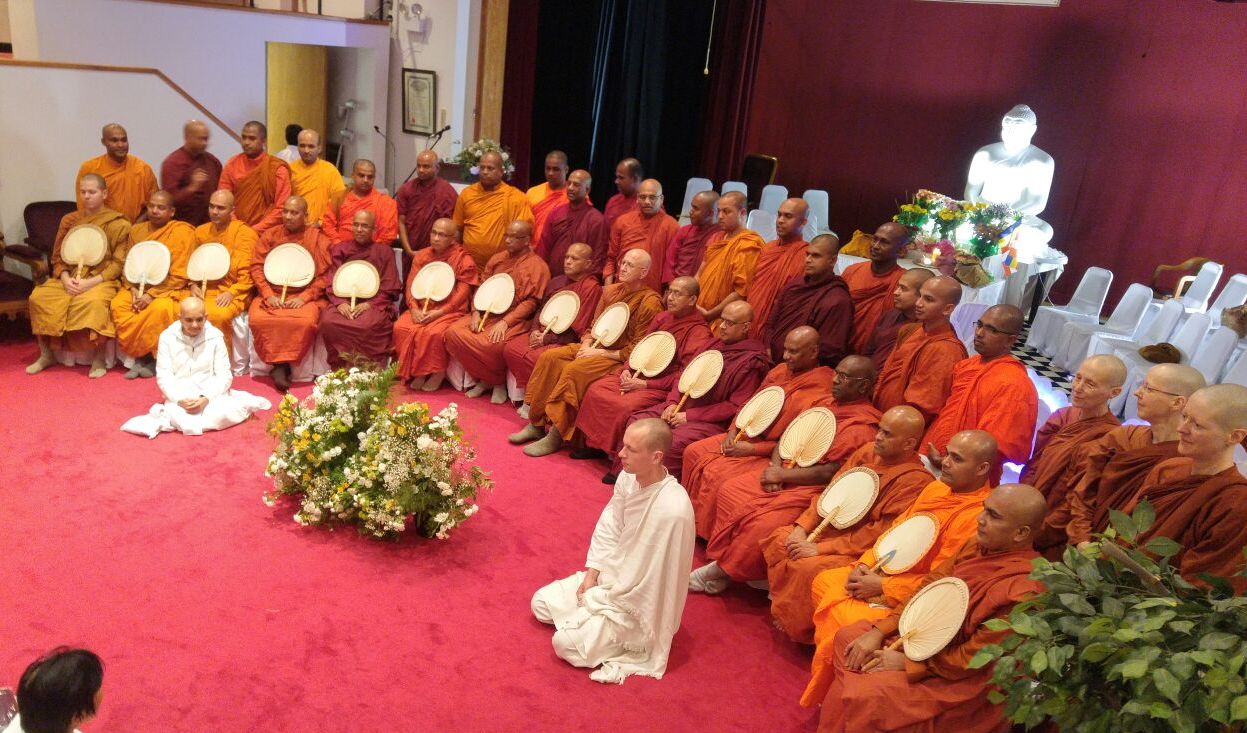
This year three Sati Saraniya nuns attended the Kathina ceremony marking the end of Vassa 2017 with the bhikkhus of Hilda Jayawardena Temple in Ottawa, Ajahn Viradhammo and some 3 dozen monastics from all over USA and Canada.
How uplifting it is to gather with wise elders and monastic brethren and the laity who encourage us in the holy life. Those who foster generosity, virtue, compassion, good-will and wisdom at a time of widespread fear, greed, and violence embody the precious blessings of the Buddha’s teachings.
May we continue to cultivate peace of heart within and around us.
May all beings live in peace and well-being.
May all beings work hard for the good of others.
October Almsgiving Ceremony
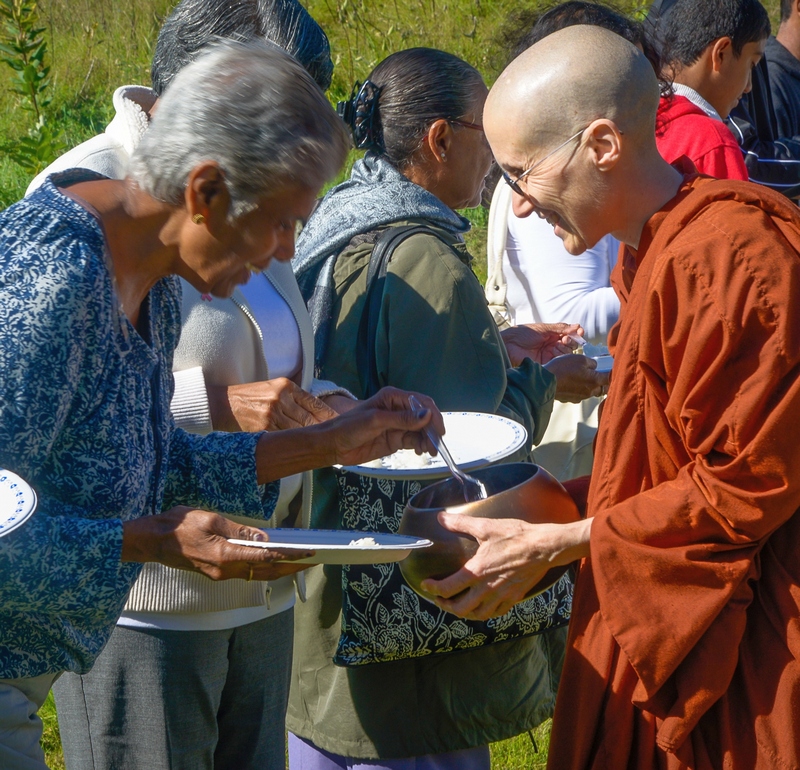
“Blessed are they who sever the ties of hatred, and,
with a tranquil heart, cultivate the way beyond suffering.”
Our ‘Vassa’ has been blessed with abundant rains and many wonderful beings in our forest. As the Vassa comes to an end, we welcome you to join us for an Almsgiving Ceremony to honour our budding Bhikkhuni Sangha on Sunday Oct. 1, 2017 .
We will be marking Ayya Medhanandi’s three decades as an alms mendicant nun as well as the bhikkkhuni ordination of Samaneri Anuruddha on Dec. 3 in California to be attended by Ayya Medhanandi and Ayya Nimmala.
The October 1st programme at Sati Saraniya Hermitage will be:
-
- 9:45 am: Arrival
- 10:00 am: Rice pindapat
- 10:30 am: Blessing and offering potluck dana
- 11:30 am: Preparation for afternoon events
- 1:00 pm: Precepts, auspicious chants & meditation
- 1:45 pm: Dhamma reflections & Almsgiving to the Sangha
- 2:45 pm: Closing Homage
Please let us know if you plan to attend, and if so, kindly carpool for this event. Your presence in itself is an offering. If you wish to also offer a requisite to the Sangha, please see the requisite list.
We have much gratitude for your many expressions of support, generosity, and loving-kindness.
Inner Disarmament
French Version: Désarmement Intérieur
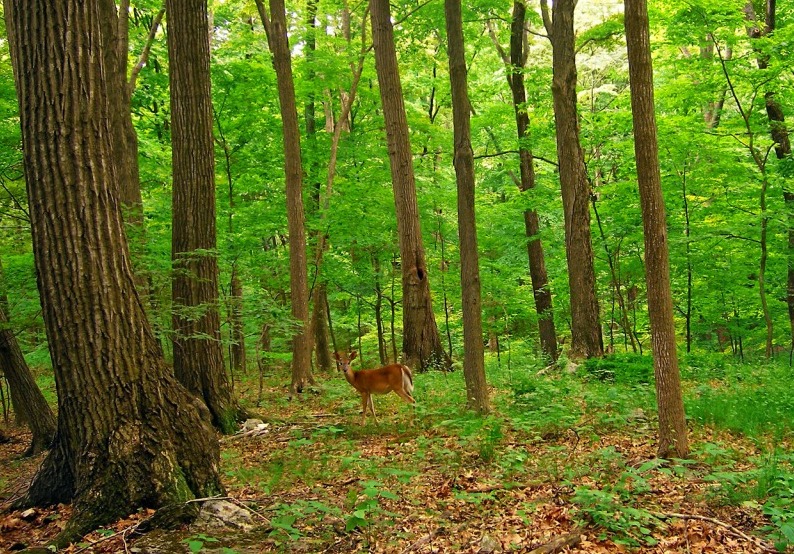
On one occasion two and a half millenia ago, the Buddha was walking alone through a forest in India when a bandit who had killed nine hundred and ninety-nine people chased him at top-speed. Even though the Buddha was walking at his normal pace, the bandit could not catch up with him. Intrigued and amazed at this phenomenon, the bandit cried out: “Stop, recluse. Stop, recluse.”
The Buddha replied, “I have stopped, Angulimala. Now you stop too.”
What had the Buddha stopped that he wanted the serial killer to stop? And what can we also stop? The Buddha wanted us to stop – not just suicide and homicide. He wanted us to stop killing the goodness in ourselves and others through our violent and destructive thoughts and emotions.
It is not easy to stop when we feel trapped in deep despair or shut off from the world; and when the desire to self-harm or to harm another has all the force of a hurricane. Likewise, a mind obsessed by jealousy, judgment, blame; or inflamed by righteous anger is more prone to violently lash out at someone else.
When we harm ourselves, we inevitably harm others. When we harm others, we ourselves are harmed. Conversely, when we feel blessed, we bless others. And blessing others, we too are blessed.
How can we effectively protect ourselves from falling prey to toxic states of mind? Ironically, the clues we need lie hidden in the ways we think about happiness in everyday life. We should consider that there is no true happiness without virtue, that is, wholesome qualities of mind, such as gratitude, truthfulness, loving-kindness, compassion.
In our pursuit of happiness, we should consider whether we feel peaceful or not. Are we filled with remorse, anxiety, sadness – or not? Whenever unwholesome mind states are present, we know that we are not on the path of true happiness.
Therefore we should always consider whether or not our actions – through body and speech – uphold ethical, wholesome, benevolent conduct. If our conduct causes no harm to ourselves or others, we should persevere in it. And if it brings harm to ourselves or others, we should avoid or abandon it – because we are no longer on the way to true happiness.
How do we manifest harmlessness? Harmlessness is gained through developing moral restraint and good-will; respecting life and being sensitive to our own needs as well as the needs of others; observing ethical precepts; and directing the mind well.
Harmlessness is a strength – a force of goodness. We are called to be courageous, kind and fearless; to be selfless rather than selfish. Good-will is the sister of harmlessness and the guardian of our inner peace.
We have to treasure these qualities of non-harming and good-will. For without them, we suffer a spiritual death. Even our critical opinions or righteous indignation have the power to murder the goodness in us or others; and they cripple our ability to forgive.
For our own moral well-being and happiness, it is important for us to recognize and remove the toxins of the mind and uproot our inner and outer ways of violence. How do we meet this challenge? What obstacles do we face?
Perhaps the greatest obstacle is not acknowledging the depth of our pain or our fear of it. We fear the inner terrorist – fear itself; our anger, and our greed; and we hold on to them. We are driven by our tenacious mental habits. They can feel unbearably painful and overpowering as if we cannot escape them.
So when fear arises, we feel immobilized to draw from our inner resources or those outside of us for help. We feel isolated and unable to articulate or even understand our own predicament. What remedies will support us in our quest to overcome these terrifying mental habits?
First, we take care of ourselves. In Buddhism, wise moral decision-making and restraint are self-care. Instead of being captive to our fear and rage, we investigate them. We see them arise, knowing them for what they truly are: insubstantial; they appear and disappear within us; and we learn how to loosen their grip until they cease. We feel much relief, release and we discover a new sense of freedom.
Also, instead of isolating ourselves, feeling unworthy or self-critical, we learn to be a friend to ourselves. And we endeavor to seek the company of true friends who, by their own good qualities, bring out our moral best.
This will help us to develop inner stability, trust, and confidence. A quiet mind gains resilience, wisdom and moral integrity. We follow a refined ethical code of thought, word and deed and train the mind to restrain the inner tyrants – those painful, unskillful states of inward or outward aggression.
This is kindness to ourselves. In being truly kind to ourselves, we could never harm anyone else. Like a mirror, whatever goodness we have within us is reflected outward for all to receive. Aggression may arise but we calm it. If we can learn to dissipate aggression in its multiple disguises by starving it, we polish the mirror.
Then, gradually, we bring mindfulness, wisdom, and self-compassion to maturity. We perfect the skill of pure attention – listening to and being truly present with unwavering awareness. Such pure presence and awareness is healing; and it is benignly contagious, opening us to a forgiving, kind and loving mind, both to ourselves and others.
This process is really nourished by meditation practice. It sharpens our ability to see and listen, brightens our awareness, and tunes us in to the tremblings and torments of the mind. When we meditate, we pacify and still the mind so that it can directly experience the truth about our own predicament.
With ongoing commitment to this path of practice, we peel away layer after layer of emotional debris and dissolve the identity that we have created around it. We see ourselves and others with greater clarity, truth, and gentleness. Instead of hating what seems unbearable, again and again and again we look with new eyes and see the emptiness of all things. Our ‘self’ view and our world view are literally transformed.
Now we have a new compass – a contemplative way of seeing that takes us wisely through the rapids of life. We use kindness, calm, intuitive insight and wisdom to get our bearings; and, in doing so, we disarm the enemies of our own well-being and happiness.
My first teacher demonstrated this to me in India many years ago, when he was shot and fatally wounded by a drunk villager. “Poor man,” was his immediate response as he lay bleeding, “He will have to go to prison now. What will happen to his children?”
And we remember how the Buddha’s absolute compassion for Angulimala stopped the bandits’ killing spree and turned his life around – the serial killer became a monk, a man of peace; and he realized full awakening. By loving one who to us seems so impossible to love, the Buddha bestowed upon him the greatest gift a human being can receive.
We too can wake up to our own innate goodness and begin to pierce through our delusion. Although we get confused by fear and hatred, and all our other human foibles, we can realize the futility of taking them to be ‘me’ or ‘mine’. They are merely energy, turbulence, heat or wind.
We have to see that and know it directly for ourselves – patiently, step by step. This is the purification of the heart. Blessing ourselves with pure awareness, we bless others. When we bless others, we, in turn, are blessed. We are free. We are at peace.
If we want this freedom and peace, each of us must do whatever we can to enter the process of inner disarmament.
Stop harming. Try forgiveness. Speak and act with kindness. Keep turning away from ill-will. Don’t give in to it. Find the pearl of goodness within you. It’s there. Touch the true happiness and unshakeable peace in your heart. It’s there.
© Ayyā Medhānandī 2017
Through the Dark Night
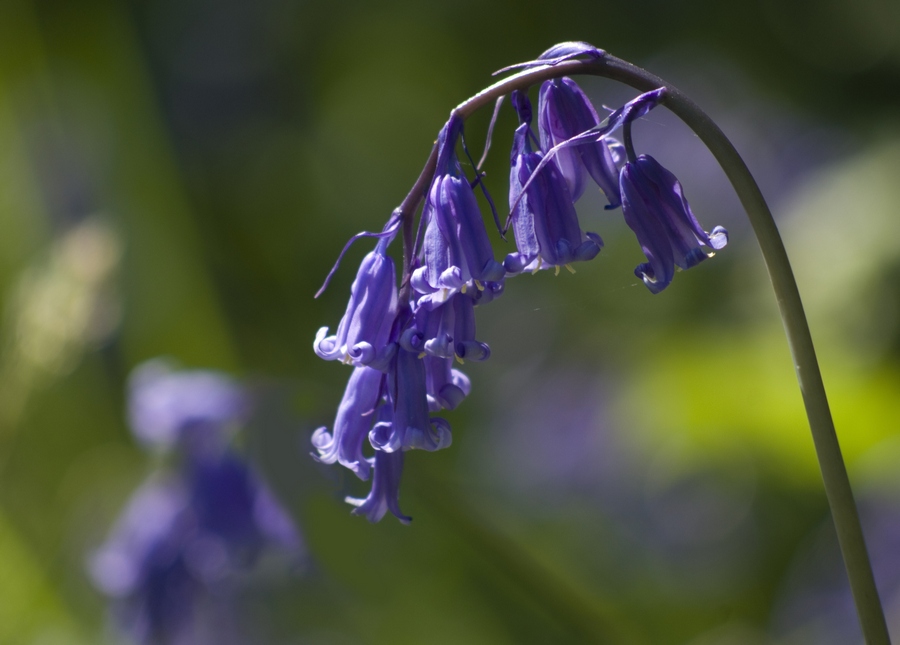 Revering the jewel of the Buddha,
Revering the jewel of the Buddha,
our greatest treasure and resource,
unequalled in this universe, immeasurable,
the supreme, excellent protection
that benefits gods and humans –
By the power of the Buddha, may you be safe,
may all dangers be prevented,
and all your sorrows pass away.
Revering the jewel of the Dhamma,
our greatest treasure and resource,
unequalled in this universe, immeasurable,
the supreme, excellent protection
which calms all fevered states of mind –
By the power of the Dhamma, may you be safe,
may all dangers be prevented,
and all your fears pass away.
Revering the jewel of the Sangha,
our greatest treasure and resource,
unequalled in this universe, immeasurable,
the supreme, excellent protection,
those worthy of respect, gifts and hospitality –
By the power of the Sangha, may you be safe,
may all dangers be prevented,
and all your sickness pass away.
Ratana Sutta
Years ago, during a dark night of the heart, I asked an elder Cistercian monk how to penetrate the darkness, how to sustain faith in one’s ability to keep going on the Path. He replied in his thick Irish accent, “When yah get really close to the sun, it burrrns.”
I listened and reflected deeply on his words. He meant for me to trust; to keep searching for light in the unfathomable depths, the interior darkness; and to persevere even though I felt unequal to the task.
We are prone to discouragement and easily underestimate our innate goodness and fortitude. We bear shame or believe that we are not good enough. But our strength and courage are not diminished thereby. They come to life as we burn through the layers of our conditioning with a generosity of heart that is both forgiving and fierce.
That burning opens us to the truth of change; and to a vastness of being beyond our frailty. It is indestructible. It is deathless. It allows us to be with the inferno of our day to day struggles, doubts, bouts of grief, fear, anxiety, shame, and so much more.
Our instinct is to run from this fire. Instead, we must keep turning towards it, balancing it with steadfast and dsicerning attention that can purify the dust of lifetimes while replenishing our strength and illuminating our minds in the process. Whatever the thinking mind presents, we notice where it takes the heart. . . and when it isn’t good, we turn down the volume and discover the emptiness of all thought waves.
We have watched and listened to these mental waves. Like the breath of the ocean, they crash ashore – rising, falling, rising, falling; sometimes dangerous, shocking, or overwhelming; sometimes smooth, pleasurable, and calming. Constantly changing, impermanent, fearful or beautiful, we have helplessly succumbed to their power. But at last, we see them with a new awareness that disarms the angst and turmoil of the mind, giving way to the voice of compassion, integrity and reconciliation.
As spiritual beings on a human journey, we discover this by opening to the spaciousness within us. Feeling our own struggle and pain – and that of others – with incisive insight, we enter into a process of waking up that is conciliatory and restorative rather than judgmental or destructive.
What is love?”
“The total absence of fear,” said the Master.
“What do we fear?”
“Love,” said the Master.
Awareness is the field of love and forgiveness, the Buddha’s map to freedom from fear and suffering. With a peaceful presence of mind, we direct attention to the heart’s native goodness. Grounded in contemplation of the body, we see the karmic repercussions of negative mind states and how to escape from them skillfully before they cause harm to ourselves or anyone else.
In this work, we will not be perfect from the ‘get go’. At times, the journey will feel too much – but we know the impermanence, suffering (dukkha) and emptiness that are universal, and that ours is the journey of all beings. Like a mountain climber, we gather the right equipment and gradually gain altitude to be able to breathe at the top.
On the path of awakening, we are emptying out delusion. First we have to awaken to all the dross within us and clear it out – moment by moment, breath by breath, day by day. At times we take one step forwards and two steps back – but we keep going. We have to learn to breathe, walk, speak and interact with a pure mind. Literally, we have to be re-trained from a to z, to let go of blind ways of seeing, thinking and knowing the contents of our lives and our minds – the ideas, opinions, and our attachments to all that we cling to. Our whole life is broken down into its components and reformatted – it is a veritable reformation.
Whatever misfortunes arise in life, through the darkest night, we learn to bow to the magnanimous face of Great Compassion. We bring forth from within – as diamonds from coal – the riches of a loving fearlessness.
Without dukkha, how would we grow free? Wherever we go, the Path is full of challenges. Dukkha is everywhere in different forms – because ultimately, its origin is within us. And it is there to be understood, and to teach us.
In the midst of the storm, at the thunder’s roll and the crashing of rain, just stop for a moment, listen within you and feel the full force of your breath pulsing in the darkness. That timeless rhythm of its tides is the ocean of life and the quiet of eternity. Therein also, we glimpse it – the faintest glow of the heart’s peace.
© Ayyā Medhānandī 2017
The Dhamma of Snow
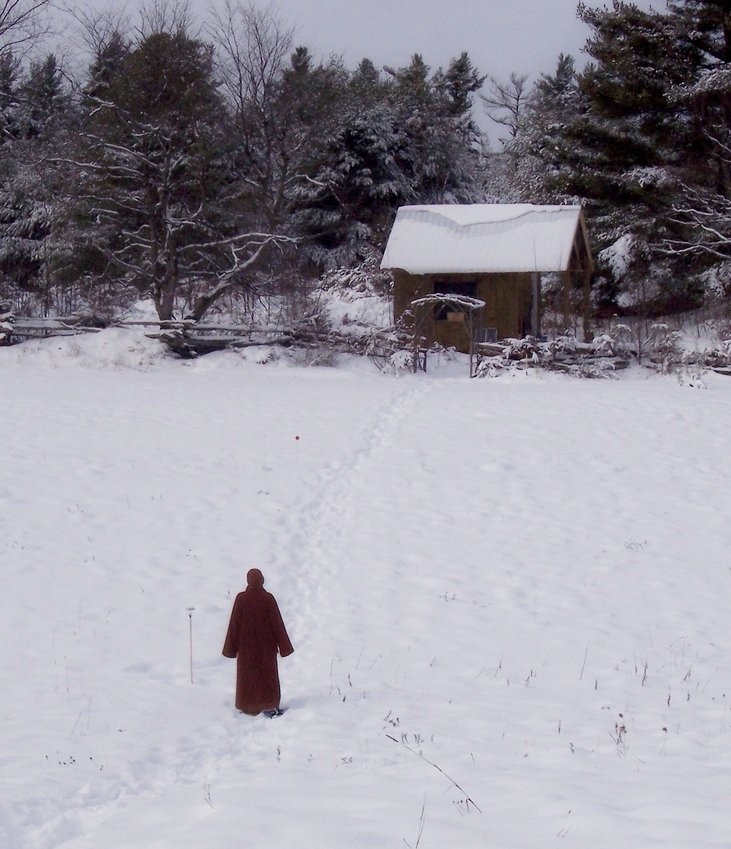
French version: Le Dharma de la Neige
One winter we had quite a lot of snow. In April, we were still navigating from building to building through narrow pathways dug into snow several feet high. The days were quite bright and sunny, and it was remarkable to us that the snow was still there.
At the end of our winter retreat, we were moving a very heavy carpet from one building to the other which none of us could lift. We managed to get it on a sled and pulled it from the main house to the meditation hall. And then, by that very afternoon, the snow was completely gone. We couldn’t understand how that had happened, literally from morning to afternoon.
One of our nuns wrote about it to her geophysicist son. This was his reply: “You seem very impressed with how the snow melted. I’m sure it was amazing to see. The world transformed overnight.
Melting is a nonlinear process, which means melting begets melting. Also, snow requires a lot of energy to change from ice to water, and this energy does not cause any change in temperature. What this means is that the snow can actually be above freezing without melting. If all the snow gets really warm over a few nice days, then it can melt all at once, really fast. As the melted snow starts to run through the unmelted snow, it helps to speed up the process. Then, when the ground appears, it absorbs much more sunlight and the melting really speeds up. The melting has probably been going on for weeks, unseen, and then the snow layer collapsed all at once.
This sort of regime shifting happens all the time in the earth sciences. Things hold on the way they are, even in very unfavorable conditions, and then at some invisible point something snaps and everything changes. Some scientists are worried our climate may act like that, that it might all of a sudden change dramatically because of the way we are forcing it.”
His description is very fitting to our practice. The first parallel that stands out is this: “Melting is a nonlinear process.” In the same way, following the Noble Eightfold path is a nonlinear process, which means “melting begets melting,” just as waking up begets waking up. As the defilements – greed, hatred, and delusion – melt away, the process of purification speeds up our relinquishment of impurity.
The melting of the hindrances, just like the snow, requires a lot of energy to change from ice to water, to change from habit to letting go. But “this energy does not cause any change in temperature.” In other words, the energy in and of itself doesn’t cause the melting to happen completely.
That means that we can still hang onto our poor habits. We can still be stuck in our ignorance, in our delusion, in our greed and our hatred, for a long time. Even if we’ve done years and years of meditation, or weeks and weeks of retreats. Even though we’ve practiced for a long, long time, it can look like nothing has happened. That’s because the defilements can hang on for a long time, even in very unfavourable conditions. They don’t like the fact that we are working to melt them. But they hang on anyway, and we get frustrated—which they do like.
The next metaphor is this: “The snow can actually be above freezing without melting. As the melted snow starts to run through unmelted snow, it helps speed up the process.” In the same way, we use effort to sustain mindfulness and diligence, with ardor, devotion, and clear comprehension. We keep working to prevent unwholesome states from continuing. We work to remove them and to encourage wholesome states to arise, and to sustain them.
If we continue that process, and give it sustained effort, then when even a little bit of the ground of awakening begins to appear, it also has a profound effect on this process. Just like the sun-warmed ground that appears beneath the snow melt, shifting and speeding the process dramatically.
From underneath, there’s an invisible letting go of those impurities that we may not even notice. Say you have a shirt that’s very badly stained, and then you bleach it or soak it. It will get really clean. But a few stains will still show themselves, and you’ll notice those more than anything. More than all that was washed away, we notice what’s left.
So it is with this process. We’ve worked so hard. We’ve made such valiant effort. And still there are impurities that we’re shocked to find. We get discouraged and may even think we should give up. “It doesn’t work!” we think, without recollecting how much we’ve already managed to cleanse, to purify, to settle, to see.
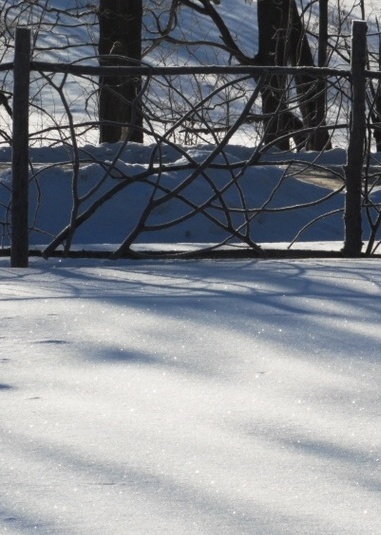 “The melting has probably been happening for weeks unseen.” Yes! Impurities have been melting and melting for months, for years, even. We may even have been doing this for lifetimes. Then suddenly, this layer of encrustation collapses. When the conditions are right and we reach a certain threshold, it falls away. A door opens, an understanding blossoms. There’s a sudden, real, penetrating insight, and a sense of realization. Something deep has been abandoned.
“The melting has probably been happening for weeks unseen.” Yes! Impurities have been melting and melting for months, for years, even. We may even have been doing this for lifetimes. Then suddenly, this layer of encrustation collapses. When the conditions are right and we reach a certain threshold, it falls away. A door opens, an understanding blossoms. There’s a sudden, real, penetrating insight, and a sense of realization. Something deep has been abandoned.
But there’s more work to do. “Things hold on this way even in very unfavorable conditions.” For the defilements, ethical behaviour, sīla; concentration, samādhi; and discernment, paññā, are most unfavourable. But for awakening, they’re very favourable. We have to remember to be patient, not to have expectations. Then one day we will find ourselves understanding suffering, dukkha, knowing its origins, observing it, and watching it end. Seeing it cease and letting the Noble Eightfold path rise up in front of us. Right view, right intention, right speech, right action, right livelihood, right effort, right mindfulness, right concentration.
How are we spending our time? How do we make our living? Are we doing the practice or are we just sitting? As Ajahn Chah said, “Even chickens sit.” We’ve sat this many hours today, but what kind of work have we been doing? How have we applied the mind during that time? The process itself may be nonlinear, but we must be relentless in our commitment to following the path.
The highest expression of our human nature is to purify our minds. To clear away the clouds, the sheets of snow, the ice that we’re encased in. We’re frozen in our fear, frozen in our anger, in our opinions, in our judgments of ourselves and of each other. We are locked in. We have to find the way to put the key in the lock, even in the dark.
To do this, we need to be able to feel our humanity, to feel our nature from the inside. Not superficially but from within, where the invisible factors of mindfulness, clarity, faith, energy, concentration, and wisdom can dismantle and dissolve years and years of deluded ways of perception, of relating to life. That’s what this practice brings about, given enough patience and diligence and surrendering to the process. It brings about a spiritual transformation. It’s invisible. We don’t know it right away, but after years we begin to see.
We see the changes in each other. We see the changes in ourselves. It’s quite remarkable. When you’re sitting with different states of mind arising and it seems interminable, trust that this process works. In some ways visibly, in other ways invisibly. Like the invisible melting of the snow beneath the crust of ice. It does work if we keep putting in the causes and conditions for mindfulness to arise, for diligence to arise, for contentment and gratitude to arise, for generosity to be expressed, for concentration to be matured, for wisdom to manifest. The results will take care of themselves. They know exactly when it’s time.
Trusting in the practice is key. We need to trust and persevere with determination. And that involves giving up. Nekkhamma, renunciation, is a giving up. Not just shaving your head and wearing robes. That’s not the real giving up. That’s just on the outside. As a friend of mine once said, you have to shave your heart. We shave our heads every week, but the hair grows right back. So we keep on doing it.
It’s a constant giving up. Giving up the pleasures of the senses. Wanting another hit, another kind of dessert, another kind of experience, another kind of retreat. Judging, evaluating, wanting, regretting, being angry, grieving – all of it. We constantly turn and twist through the contortions of human life until we find that place where we can see through to our true nature, and the pure mind comes into view like a bright moon.
This is a complete letting go of conditioned things, conditioned experiences, conditions in their worldly way, and giving ourselves to that which is unconditioned, until it rises up within us. We cannot find the unconditioned out in the world. We can only know it in the heart. It arises from this very body, which is death-bound, which must be washed and cleaned and tended to, and that dirties the clothing we wear. Out of this dirt-producing, odour-producing body can come an awakened mind, can come transcendent beauty.
So we use the body. We respect it and honor it for the purpose of spiritual awakening, not as a pleasure-producing entity. Our goal is not to squeeze out every last ounce of joy and pleasure from worldly things, but finally to arrive at that farther shore that we’ve been striving for. This is the meaning of the human journey for those who are willing to trust and stick to the practice.
When we allow the mind to get overexcited, overheated about things that have already happened, or about the future, we’re deepening the groove of our mental bondage. To allow anger to abide in the mind, to allow unwholesome states to pervade the mind, is like allowing Mara to sit on our backs. That won’t help collapse the kilesas, the impurities of the heart.
Everything is contained in these teachings. They’re so vast. My revered teacher Sayadaw U Pandita, the renowned Burmese meditation master, always told me, “Don’t read the books. Read your heart first.” If we study our own hearts, we’ll find that everything is written there. Everything. And if we study the suttas, we can hear the Buddha’s words and they will encourage us to keep practising.
Even when daggers have been thrust into our hearts, when we’ve experienced the most painful thing imaginable, like a mother and father losing their own child, we can still find peace through the practice. We do this by investigating the very ground of our being and discovering that there is no being in there. No solid being that we can call “me” or “mine.” Even in the face of terrible loss, we can see through the pain to the ending of pain. Not only for ourselves, but for all beings.
That’s what our journey represents: the possibility of going to the Everest of the spiritual realm. That might seem impossible from where we sit now, but we have to trust this process. And like the sudden vanishing of the winter snow, it’s nothing short of magnificent.
© Ayyā Medhānandī Bhikkhunī
Tricycle Magazine, USA, 2016, reprinted with permission
A Winter Blessing
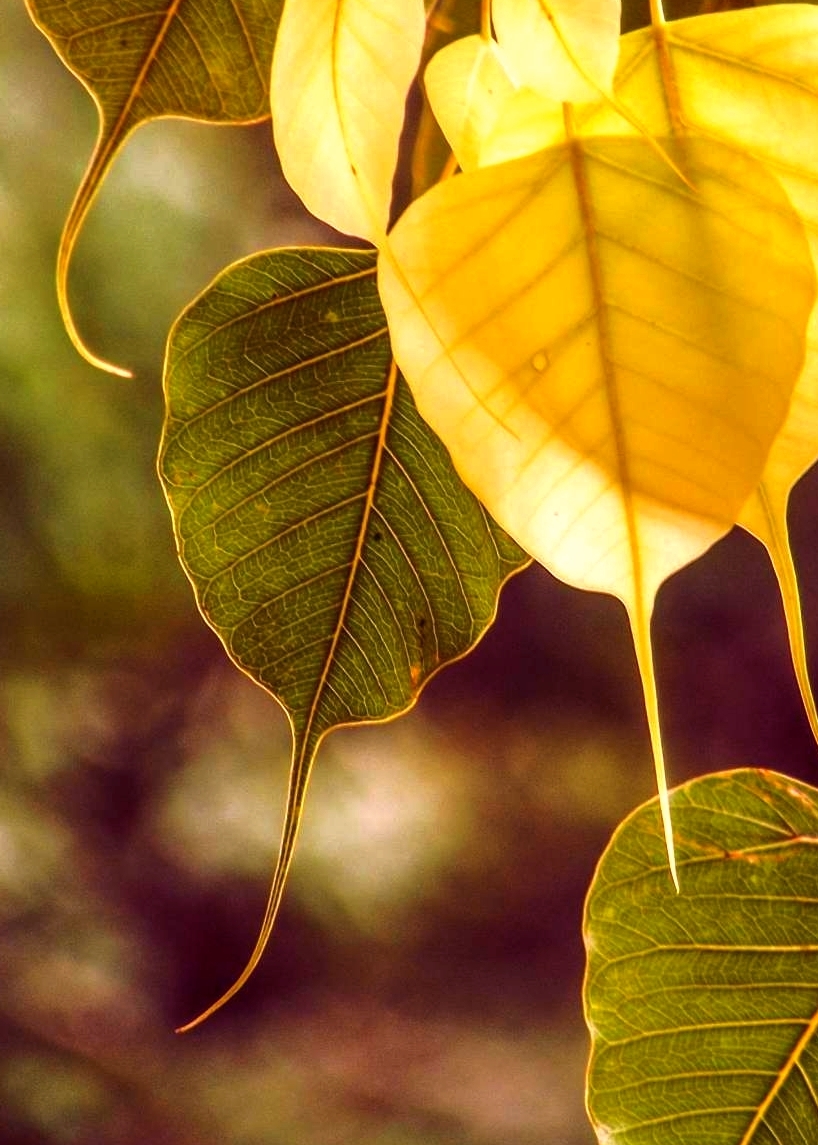
The Ratana Sutta chant, Verses on the Treasures of the Dhamma:
Visakha, the Buddha’s devotee, reflects on her generosity to the Sangha:
“When I remember it, I shall be glad.
When I am glad, I shall be happy.
When my mind is happy,
my body will be tranquil.
When my body is tranquil,
I shall feel pleasure.
When I feel pleasure,
my mind will become concentrated.
That will bring the development
of the spiritual faculties . . .
the spiritual powers,
and the enlightenment factors
in me.”
Vin. 1:290-94
